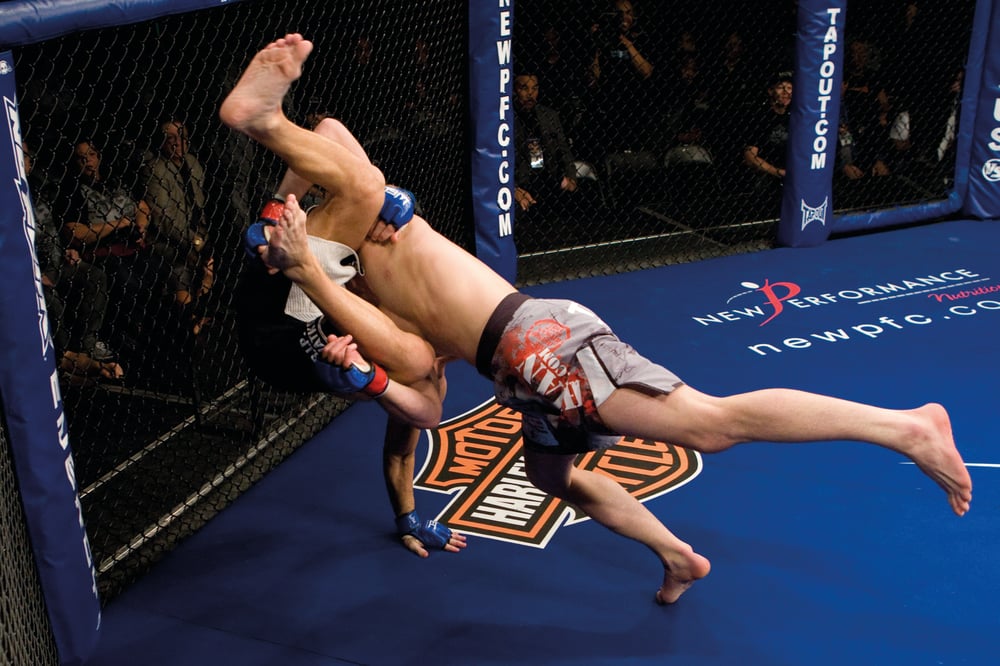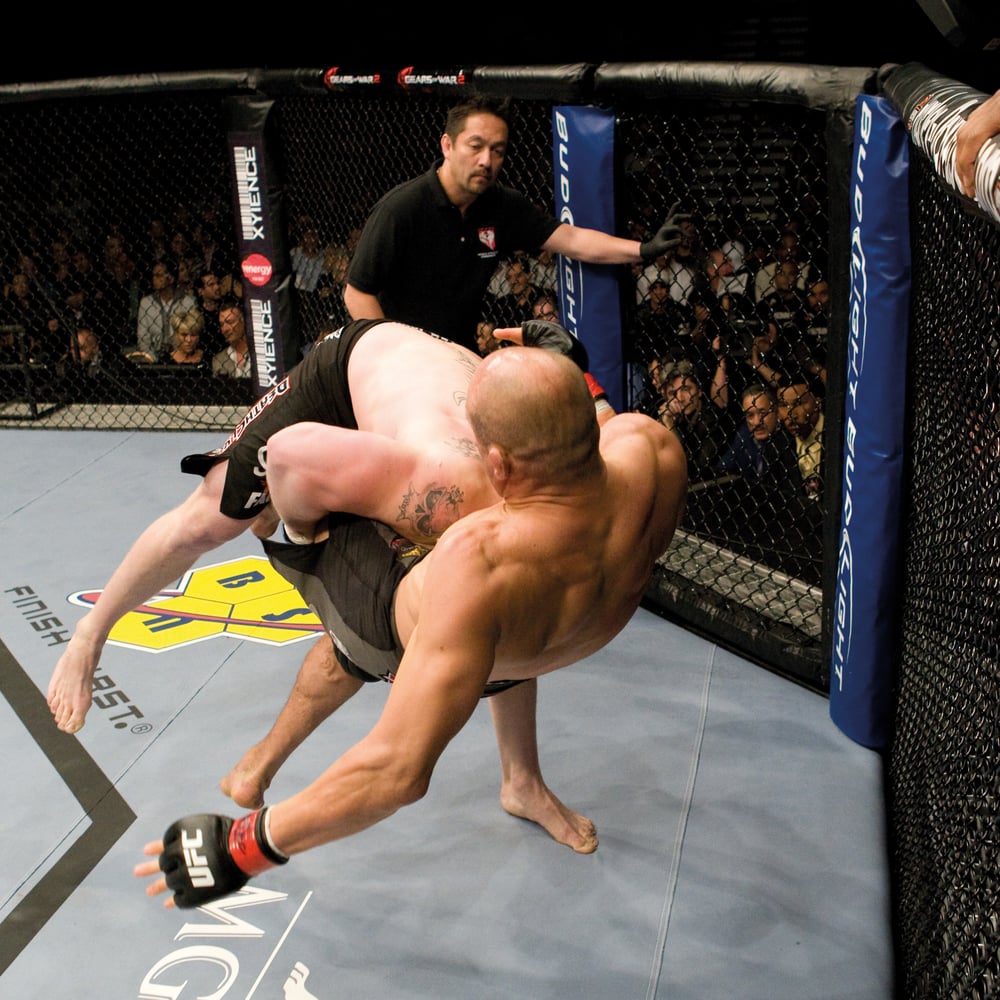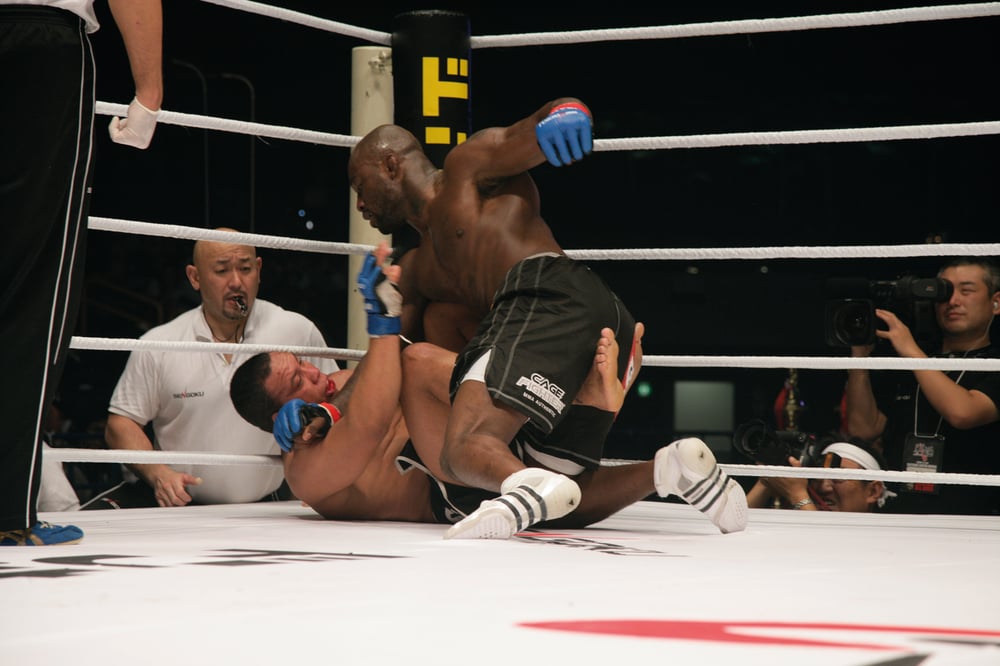
Issue 049
May 2009
Inspired by the success of many top fighters who credit the ‘world’s oldest sport’ as their background, a new generation of dynamic, tough and exciting wrestlers are entering MMA. Andrew Garvey takes a look at the new smashing machines.
The old guard
In 1996 former Olympic wrestler Mark Coleman revolutionised the pseudo-sport of ‘No Holds Barred’ fighting. Originator of the ground ‘n pound style, he simply took his opponents down and smashed them into the mat with fists, forearms, elbows and headbutts. Coleman built his entire career on this strategy.
In 1997 his friend and protégé, the 1992 NCAA (National Collegiate Athletic Association) Division I 190lb wrestling champion Mark Kerr, appeared to have perfected the art. Fighting at an immense, in-shape 250lb, Kerr was bigger, younger, and boasted more stamina and submission awareness than Coleman. Utterly devastating in his first few fights, there was a time when Kerr looked nigh on unbeatable.
The world has changed since then. At 40, Kerr looks more like some bloated relative of the original ‘Smashing Machine’ than the man himself, his spectacular decline prompted by half a medical dictionary’s worth of injuries, a turbulent personal life, and a painkiller addiction so serious it almost killed him. Sporting a sad 2-7-0 record since returning to action in 2004, the once-titanic Kerr is almost unrecognisable from the truly dominant physical force who graphically demonstrated just how applicable high-level wrestling is to the sport of fighting.
At 44 years of age, UFC Hall of Fame member Coleman recently battled Mauricio ‘Shogun’ Rua deep into the third round of a truly dramatic fight. Exhausted within three minutes, the proud old warrior stubbornly fought on, even complaining bitterly when the referee stopped the fight with 24 seconds remaining.

The existing elite
Coleman and Kerr’s time at the top has long gone but there’s certainly no shortage of elite wrestlers in the game. Some, like Randy Couture, Matt Hughes, Dan Henderson and Sean Sherk are major stars or top contenders with fighting careers stretching back to the 1990s.
Others, like welterweight contenders Jon Fitch and Josh Koscheck, are younger, highly-ranked fighters with impeccable college wrestling credentials. Fitch captained the highly respected Purdue team before breaking into MMA in 2002, while Koscheck was Division I NCAA champion in 2001 and a four-time All American at 174lb.
In addition, a new generation of smashing machines, many of them younger and more finely tuned than the old guard, are on the march, bringing more than just superb wrestling ability with them. With experience in pressurised one-on-one competition and the rigours of training and weight-cutting, they have already begun to make a major impact on MMA. Over the next few years they may well come to dominate and change the entire sport all over again.
Team takedown
Fighters Only spoke to three Division I All American wrestlers at Oklahoma State University (OSU) who now fight professionally. Jake Rosholt, Johny Hendricks and Shane Roller are all members of Team Takedown, an innovative management group formed in 2007 with the mission to seek elite wrestlers and turn them into MMA champions. After just a few fights, all three inked WEC contracts and relocated to Las Vegas, splitting time between the highly respected Master Toddy’s Muay Thai, BJJ guru Marc Laimon’s Cobra Kai and talent-rich MMA camp Xtreme Couture, headed up by former OSU wrestler, ‘the Natural’.
Middleweight Jake Rosholt is 5-1-0 in MMA and considered one of the best collegiate wrestlers of the past decade. A three-time NCAA Division I champion, lifting the 184lb title in 2003 along with a pair of 197lb titles in 2005 and 2006, the 26-year-old has a ferocious work ethic and relentless fighting style. Last November he thrilled the crowd in a wild WEC brawl with Nissen Osterneck. Rosholt’s stand-up looked raggedly enthusiastic, but he showed a great chin, stamina, and submission defence finishing his exhausted opponent with some nasty punches on the ground. Rosholt told us “Moving to Vegas has allowed me to progress much more quickly than I would have elsewhere. I don’t do much, if any, just pure wrestling any more. Mostly striking and submission work.”

Undefeated at 5-0-0, welterweight Johny Hendricks is a four-time All American, and twice NCAA Division I champion at 165lb. In his fourth fight Hendricks had a rough first round, being shockingly taken down twice and out-struck on his feet. But the 25-year-old turned things around in style in the second. Flooring his opponent with a neat left uppercut, Hendricks pounced and pounded out a TKO victory. Hendricks quickly learned he needed to do far more than just wrestle once he got in the cage. “After my first fight I started to stay on my feet because that is where every fight starts at and I need to be comfortable with my stand-up game, so when I start fighting better strikers I can hold my own and get them to the ground.”
Shane Roller, a 29-year-old lightweight, rebounded from a debut defeat to record five straight first-round wins. A three-time All American wrestler from 2000 to 2002, Roller’s last fight saw him require just 61 seconds to take down and choke out his previously unbeaten opponent. Roller noted just how much he relied on his wrestling to begin with. “All I knew was wrestling so that’s all I did. Now, since I’ve been training with some great stand-up and jiu-jitsu guys, I feel more comfortable in those areas as well. I’m sure I’ll always rely on my wrestling more than the other techniques, but I’m trying to become not so one-dimensional like I was when I started out. I don’t do much wrestling training at all. I do drill some of my takedowns, especially against the cage because the takedowns you would do in a wrestling match are not the exact same as what you would want to do in an MMA fight.”
The new heavyweight smashing machines
Traditionally, some of the most dominant wrestlers in MMA have competed at heavyweight. That legacy continues in 2009 with a trio of brutally strong, aggressive, athletic UFC heavyweights with stellar wrestling backgrounds. The American Kickboxing Academy in San Jose, California, is the home of fast-rising, undefeated heavyweight Cain Velasquez. Twice an All American Division I wrestler at Arizona State, (where MMA legends Dan Severn, Don Frye and Dan Henderson competed) the 26-year-old is a truly frightening prospect inside the Octagon and already legendary in the gym for his limitless energy and sheer talent. A week before his July 2008 annihilation of Jake O’Brien, Velasquez sparred with, and utterly dominated, Brandon Vera for two straight rounds, before doing exactly the same to a fresh Mike Kyle, and then Paul Buentello. Simply put, Velasquez is already a tremendous fighter with plenty of time to get even better. Somewhat slowed by a knee injury, and his minutes in the Octagon limited by his own destructive success, Velasquez has yet to fully show his true potential but looks destined for the very top of the heavyweight division, currently ruled by another former collegiate wrestling star.

UFC Heavyweight champion Brock Lesnar took the NCAA Division I title as a heavyweight in 2000, improving on his second-place finish the previous year. Four years of college wrestling saw him amass a superb 106-5 record. Lesnar also happens to be one of the most gifted athletes in modern sports history, having been a champion amateur wrestler who mastered the athletic performance-art of pro wrestling, before coming impossibly close to an NFL career despite no college football experience, and then destroying MMA legend Randy Couture to lift the UFC title. That second-round victory proved Lesnar is already one of the best, most effective heavyweights in the entire sport, despite being just four fights and less than two years into his MMA career.
Between them, Lesnar and Velasquez could dominate the UFC heavyweight division for a good while yet; though yet another high-level wrestler may have title aspirations of his own. Unbeaten at 11-0, boasting gigantic fists and concussive power, Shane Carwin has finished every fight in the first round and at times looked utterly terrifying. Most memorably, his UFC debut saw a ferocious right hand send the unfortunate Christian Wellisch’s mouthpiece flying through the air, and Wellisch himself slumping to the mat, unconscious. Carwin won the Division II NCAA heavyweight title in 1999 after twice finishing second in 1996 and 1997.
Changing the game
Together, Lesnar, Velasquez, Carwin, the Team Takedown crew and all the other elite wrestlers entering the cage or ring may well change the entire sport. At the most basic level, they can do what Coleman, Kerr and Hughes did a decade ago: impose their will, their physical strength, their leverage, their takedowns, their ground control and their wrestling on their opponents. In response to this other fighters will be forced to spend more and more time on countering wrestling.
Yet, even as they do so, the new smashing machines are constantly adding to their own skills, learning to strike, submit, and generally stay ahead of the curve. Johny Hendricks noted that high-level wrestling means a fighter can “control where you want the fight to go. If you’re losing the stand-up battle then you can take them down. If you’re winning the stand-up battle and the other guy tries to take you down then you can stop them from doing it.”
But what happens from bell-to-bell is only part of the reason why elite wrestlers look poised for ever more fighting success. Hendricks says “weight-cutting is a big part of MMA and yes, being able to do that for the last eight years of my life it comes easy and yes, knowing that I can push through almost any injuries that come my way in a training camp helps me know that I am mentally prepared for anything that comes my way in a fight.”
Fights are often won and lost long before the opening bell. What happens in training is of utmost importance. So is being able to cope with the mental stress, and the pressure of competing at the highest level. Jake Rosholt told us “the biggest advantage [elite wrestlers have] is the fact that you have been in many one-on-one competitions in your life and know how to prepare yourself for those types of situations.”
Shane Roller discussed the mental aspect further. “Because I’ve wrestled my whole life I know what to expect and what it is going to take to get to the top. I think the reason wrestlers are doing well in the sport is because wrestlers have a certain mentality that they’ve been taught their whole life. I think the ‘wrestler’s mentality’ teaches them to be strong during all the weight-cutting, injuries, gruelling practices, hard conditioning, etc. I think it is overwhelming for many fighters, but wrestlers have been there, done that.”

ONES TO WATCH
Profiling all the elite wrestlers breaking into MMA would likely take up this entire issue. More and more high-level collegiate wrestlers, seeing the success of their peers, are putting on the 4oz gloves and fighting professionally. Our handy table gives you a quick glance at ten of the most important names to watch out for.
Ryan Bader 8-0
Two time NCAA Division I All American at 197lb. 25-year-old light-heavyweight winner of TUF8.
Aaron Anspach 1-0
NCAA Division I All American at heavyweight, 2007.
Henry Cejudo 0-0
Freestyle Olympic gold medal at 121lb, 2008. Training in boxing, heavily rumoured to be considering a career in MMA. Just 22 years old.
Efrain Escudero 11-0
7th place, Junior College Nationals, 2007. Lightweight winner of TUF8. Underrated submissions: 9 of his 11 wins by tap out.
Jon Jones 8-0
National Junior College champion, 2007. Explosive light heavyweight. Just 21 years old.
Phil Davis 3-0
Four-time NCAA Division I All American. NCAA Division I title at 197lb, 2008. Tall, athletic, progressing well as a striker.
C. B. Dollaway 8-1
Junior College National Champion. NCAA Division I All American at 184lb, 2006. Middleweight runner-up of TUF7.
Cole Konrad 0-0
Four-time NCAA Division I All American. NCAA Division I heavyweight titles, 2006 and 2007. Training partner of Brock Lesnar. Rumoured to be moving into MMA in 2009.
Jacob Volkmann 8-0
NCAA Division I All American, 2001, 2003 and 2004. Fights at welterweight.
SHOOTING STARS
Suddenly, MMA seems on the verge of being overrun by elite wrestlers. Here’s just three of many names to watch out for over the next couple of years.
Muhammed Lawal
An extraordinary talent, Lawal was an All American wrestler in Divisions I and II and a member of the US national freestyle team. The 28-year-old failed to qualify for the Beijing Olympics and turned to MMA, training under Dan Henderson at Team Quest. His fighting debut for Japan’s Sengoku promotion was a stunning one. Stepping in as a late replacement and renamed ‘King Mo’, Lawal made his regal entrance and shockingly TKO’d Travis Wiuff, a veteran of over 60 MMA fights. Since then Lawal has scored another pair of victories, showing off his speed, athleticism, an intelligent finishing instinct, and a tremendous overall potential in his new sport.
Ben Askren
Scheduled to make his MMA debut in early 2009, Askren is a two-time NCAA Division I champion at 174lb, lifting the title in 2006 and 2007 after twice coming second in 2004 and 2005. The lanky, wild-haired, energetically unorthodox Askren’s final collegiate record was a stunning 153-8, and he twice won the Dan Hodge trophy (awarded each year to the most outstanding college wrestler). A Brazilian jiu-jitsu purple belt and member of the American Top Team, the 24-year-old has the time, talent and opportunity to be something truly mould-breaking in MMA.
Chad Mendes
Among the best wrestlers in the history of Cal Poly – a California college with a rich wrestling heritage – Mendes placed second in the 2008 NCAA Division I championships at 141lb. Fresh out of college and an intense competitor, he trains with WEC superstar Urijah Faber. Featherweight Mendes impressed in his only MMA fight (so far), submitting his opponent in the first round. Mendes should certainly be picking up the submission game, since in his NCAA final he tore ligaments in J Jaggers’s ankle with a hold that almost looked like an ‘accidental’ leglock.










